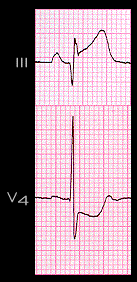
In contrast, deviation of the ST segment from baseline, either with or without associated T wave changes, indicates the development of abnormal voltage gradients during the plateau phase of the ventricular action potential and is almost always a manifestation of cardiac disease, the result of electrolyte abnormalities, or the effects of cardioactive drugs. In the example shown here, the ST segment changes are the result of an acute myocardial infarction.
